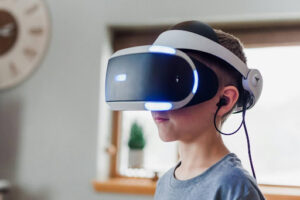It’s no secret that the healthcare and medical fields are two industries ripe for innovation. Over the years, healthcare and medical professionals have experimented with some of the newest technologies, such as artificial intelligence (AI) and machine learning (ML), the internet of medical things (IoMT), big data, 3D printing, radio frequency identification (RFID) technology and many more.
One category of technology expected to have a significant impact on health care is virtual reality (VR). While VR is often associated with gaming, it has numerous applications in the medical field. Healthcare practitioners are exploring some VR applications, one being VR simulations for surgical training.
Learn more about VR, its role in a modern operating room (OR), and whether or not VR-based surgical training is effective.
An Overview of VR in Health Care
VR is a relatively new technology that combines software and hardware to provide immersive simulated environments for its users. While it seems realistic to users, it’s an all-enveloping and artificial experience that obscures the natural world.
Outside of the healthcare sector, VR is proving itself as an extremely useful innovation across a range of industries, such as retail, manufacturing, real estate, tourism, and construction.
For example, retailers use VR to create novel shopping experiences. Real estate agents conduct virtual home tours for prospective buyers. Some of the world’s most fascinating museums offer VR field trips for students. As you can see, VR will only become more widely used in the coming years.
VR also has several healthcare applications, according to the U.S. Chamber of Commerce:
- Helps with pain reduction strategies
- Simulates health conditions such as Parkinson’s, dementia, and migraines, so doctors and other medical professionals can feel firsthand what patients are experiencing
- Improves patient rehabilitation, physical therapy, and motor functioning
- Assists older adults with memory and cognitive function
- Addresses mental health disorders such as anxiety, PTSD, depression, and phobias
These five applications provide a glimpse of what VR can achieve in health care. One application missing from the list, but no less significant, is the use of VR for surgical procedures and training.
How VR Assists With Surgeries
Patients require surgery for many reasons, such as to relieve or prevent pain, improve bodily function or diagnose a medical condition. Some operations determine whether or not a patient survives, making surgery a critical aspect of modern health care.
Researchers, scientists, doctors, and other medical professionals must have the latest technologies at their disposal, which is why VR is now used by plenty of healthcare professionals nationwide.
“Modern VR allows surgeons to look inside a patient’s body before procedures, enabling them to complete procedures more efficiently.”
The George Washington University Hospital uses an advanced VR tool – called Precision Virtual Reality by Surgical Theater – for neurosurgery and thoracic surgery. Amazingly, the tool enables surgeons to peek inside a patient’s brain and body before performing a surgical procedure. As a result, surgeons can operate more efficiently and the tool improves their situational awareness.
Many other hospitals and medical professionals are leveraging VR. Lucile Packard Children’s Hospital Stanford’s CHARIOT program has VR available in every unit to distract young patients and keep them engaged when undergoing various hospital procedures.
Modern Surgery Needs New Training Methods
VR-based solutions in health care are changing the industry for the better. However, another VR application in the sector is surgical training for medical students and seasoned clinicians.
According to pediatric orthopedic surgeon and CEO and co-founder of Osso VR, Justin Barad, MD, suggests that modern surgical training is 10 times harder to learn than it was in the past. Barad claims that traditional procedures might have a learning curve of around 10-20 cases, meaning students must operate on 10-20 patients to become proficient.
However, minimally invasive procedures and those using modern robotics typically require around 50-100 cases to achieve proficiency. Ultimately, medical students must scrub into as many surgeries as possible to gain direct experience and actively participate in patient care.
“Minimally invasive surgeries or procedures using modern robotics typically require students to complete around 50-100 cases to achieve proficiency.”
How can students become skilled in these procedures without access to new training methods? This is one reason why Barad and his colleagues founded Osso VR. The company offers a VR-powered surgical training and assessment platform for aspiring surgeons.
Is Using VR an Effective Method for Surgical Training?
Using VR for surgical training sounds ideal on paper, but the real question is: How effective is it?
According to a systematic review from the Journal of Surgical Research, immersive VR incorporation in surgical training programs is supported by high-quality studies and offers these benefits:
- Improved procedural times
- Positive user ratings, citing high satisfaction and low discomfort
- Task completion and accuracy
- Cost-effectiveness
At the Williamson Medical Center in Tennessee, Dr. Cory Calendine is the chief of orthopedic surgery and an orthopedic surgeon and founder of the Bone and Joint Institute of Tennessee. In a recent interview, Dr. Calendine said he was immediately impressed with Osso VR’s training technology.
“Students can practice procedures on their own time without posing any risks to patients.”
Dr. Calendine finds VR training so promising because students can practice procedures on their own time and without posing any risks to patients. Additionally, Dr. Calendine acknowledges that the platform measures performance and proficiency at all training levels, which is highly valuable.
VR for surgical training has the potential to be highly effective, but only if aspiring and experienced surgeons can access the necessary VR software and hardware.
Unfortunately, the U.S. suffers from uneven access to technology, particularly in the education sector. While VR equipment is becoming increasingly affordable, some medical students will face barriers to accessing VR tech, thus missing out on these revolutionary training opportunities. As for the future, more research is needed to continue measuring VR’s effectiveness in surgical training, but now, its future looks promising.
Expect VR to Become a Staple in Future ORs
Anyone in the medical field knows that surgical training is ongoing, even for the most experienced surgeons. Aspiring and veteran surgeons can greatly benefit from VR-based surgical training methods.
Since VR is still in its early stages in health care, it’s uncertain whether or not VR-based surgical training is as effective as traditional training methods. It’ll be interesting to see how VR changes health care and surgery and whether it helps create the next generation of skilled surgeons.










